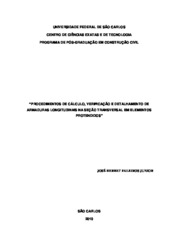| dc.contributor.author | Faleiros Junior, José Herbet | |
| dc.date.accessioned | 2016-06-02T20:09:13Z | |
| dc.date.available | 2010-10-22 | |
| dc.date.available | 2016-06-02T20:09:13Z | |
| dc.date.issued | 2010-08-24 | |
| dc.identifier.citation | FALEIROS JUNIOR, José Herbet. Calculation procedure, verification and detailing of longitudinal reinforcement in the cross section of prestressed elements. 2010. 193 f. Dissertação (Mestrado em Ciências Exatas e da Terra) - Universidade Federal de São Carlos, São Carlos, 2010. | por |
| dc.identifier.uri | https://repositorio.ufscar.br/handle/ufscar/4654 | |
| dc.description.abstract | The following paper presents methods of calculation, verification and detailing of prestressed longitudinal reinforcement in cross sections of elements subjected to bending conceptualizing prestressing systems and its constituent elements, as well as the development of practical examples, calculated and detailed in a didactic manner, seeking an easy understanding and learning. The present study chooses to calculate the longitudinal reinforcement at the ultimate limit state and check it out at the serviceability limit state, always following the current standards. To organize the concepts and cohesion of the information, it is necessary to discuss theoretical and conceptual foundation by assembling several authors who derive about the subject matter. In order to ensure the adoption of normative recommendations (NBR6118:2007 e NBR9062:2005), issues such as durability, cover, classes of environmental aggressiveness, combinations of calculating and limiting values of prestress are discussed. As an example, it is presented a calculation discussion from a structure tailored to different classes of environmental aggressiveness, maintaining its main features, such as: the vain, the cross section and loads. With this work we realize that the calculations are needed, since there is not a situation which determines the scaling of the longitudinal reinforcement. Lastly, we present suggestions for future papers. In order to maintain the geometric features needed to the placement of the active armor on the top edge and on the replacement of the active armor by the passive one at any percentage can only be accomplished in partial prestress. The concurrent examinations may prevent the use of certain sections, for example, when examinations on empty are exclusive, or when the moment value relative to the weight itself is small in relation to the total moment. | eng |
| dc.format | application/pdf | por |
| dc.language | por | por |
| dc.publisher | Universidade Federal de São Carlos | por |
| dc.rights | Acesso Aberto | por |
| dc.subject | Concreto protendido | por |
| dc.subject | Armaduras | por |
| dc.subject | Detalhamento construtivo | por |
| dc.subject | Dimensionamento | por |
| dc.subject | Prestessed active reinforcement | eng |
| dc.subject | Pre-tension | eng |
| dc.subject | Pos-tension | eng |
| dc.subject | Prestressed | eng |
| dc.subject | Cross section | eng |
| dc.subject | Design | eng |
| dc.subject | Detailing and longitudinal reinforcement | eng |
| dc.title | Procedimentos de cálculo, verificação e detalhamento de armaduras longitudinais na seção transversal em elementos
protendidos | por |
| dc.title.alternative | Calculation procedure, verification and detailing of longitudinal reinforcement in the cross section of prestressed elements | eng |
| dc.type | Dissertação | por |
| dc.contributor.advisor1 | Carvalho, Roberto Chust | |
| dc.contributor.advisor1Lattes | http://lattes.cnpq.br/3633394168236221 | por |
| dc.description.resumo | O presente trabalho apresenta métodos de cálculo, verificação e detalhamento de armaduras longitudinais protendidas nas seções transversais de elementos submetidos à flexão conceituando os sistemas de protensão e seus elementos constituintes, bem como, o desenvolvimento de exemplos práticos, calculados e detalhados de maneira didática, visando um fácil entendimento e aprendizado. Neste trabalho opta-se por calcular a armadura longitudinal no estado limite último e verificá-la no estado limite de serviço, seguindo sempre as normas vigentes. Para a organização dos conceitos e coesão das informações, faz-se necessária a discussão teórica e o embasamento dos conceitos através da reunião de diversos autores que discorrem sobre o assunto abordado. Pretendendo garantir a adoção das recomendações normativas (NBR6118:2007 e NBR9062:2005), são discutidas questões como durabilidade, cobrimentos, classes de agressividade ambiental, combinações de cálculo e valores limites de protensão. Na forma de exemplo, é apresentada uma discussão de cálculo a partir de uma estrutura dimensionada para variadas classes de agressividade ambiental, mantendo suas características principais, como: o vão, a seção transversal e os carregamentos. Com o trabalho percebe-se que são necessários os cálculos, pois não há uma situação determinante para o dimensionamento da armadura longitudinal. Para que se mantenham as características geométricas é necessária a colocação de armadura ativa na borda superior e na substituição da armadura ativa pela passiva em qualquer porcentagem só pode ser realizada na protensão parcial. As verificações simultâneas podem inviabilizar o uso de certas seções, por exemplo, quando as verificações em vazio são excludentes, ou quando, o valor do momento relativo ao peso próprio é pequeno em relação ao momento total. Por fim são apresentadas sugestões para trabalhos futuros. | por |
| dc.publisher.country | BR | por |
| dc.publisher.initials | UFSCar | por |
| dc.publisher.program | Programa de Pós-Graduação em Engenharia Civil - PPGECiv | por |
| dc.subject.cnpq | ENGENHARIAS::ENGENHARIA CIVIL::ESTRUTURAS::ESTRUTURAS DE CONCRETO | por |
